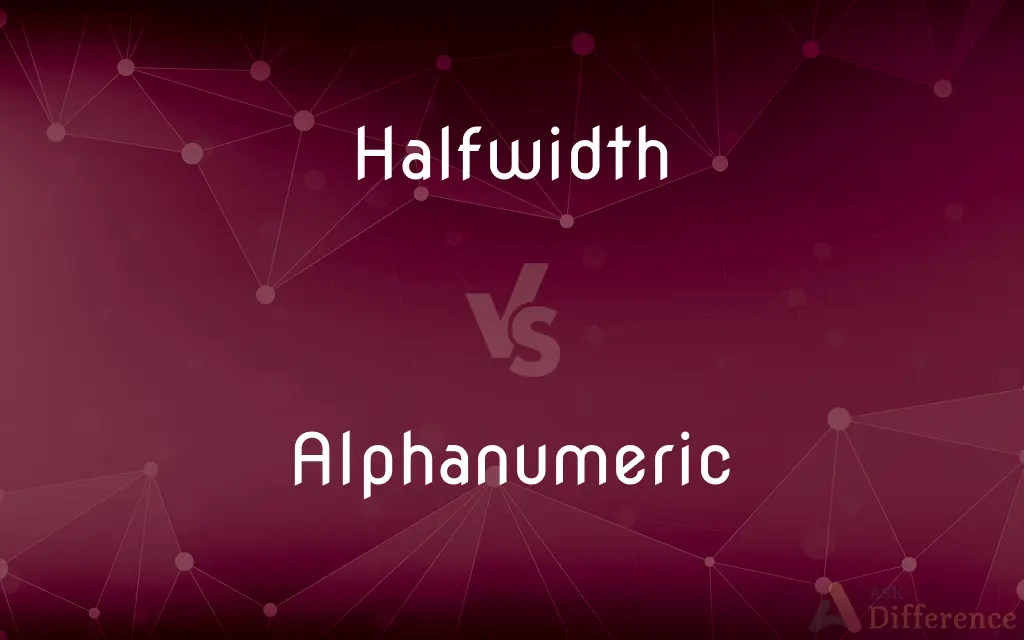Halfwidth vs. Alphanumeric — What's the Difference?
By Tayyaba Rehman & Fiza Rafique — Updated on April 2, 2024
Halfwidth characters occupy half the standard space of a full-width character, used in East Asian typography, whereas alphanumeric characters are letters and numbers used in most written languages.

Difference Between Halfwidth and Alphanumeric
Table of Contents
ADVERTISEMENT
Key Differences
Halfwidth characters are designed to align neatly in a grid, conserving space in languages like Japanese and Chinese, where full-width characters are standard. This feature is particularly useful in digital displays and computing where horizontal space is limited. On the other hand, alphanumeric characters refer to the combination of alphabetic (letters) and numeric (digits) characters, prevalent in virtually all written languages and essential for creating words, sentences, and numerical data.
While halfwidth characters are a typographic specification mainly applicable in East Asian text layouts to ensure clarity and readability in compact spaces, alphanumeric characters are a fundamental component of textual data, used universally without specific constraints on their width or spacing. Whereas halfwidth characters address spatial and aesthetic considerations in text presentation, alphanumerics focus on content representation.
Halfwidth characters serve a specific purpose in computing and electronic communication, especially in environments where space efficiency is critical, such as on electronic displays or web interfaces. Alphanumeric characters, however, are used across various applications worldwide, from forming the basis of literary texts to coding and data entry, demonstrating their versatility across contexts.
The use of halfwidth characters is particularly important in coding systems and databases where character width can affect layout and design. In contrast, alphanumeric characters are foundational in both computing (e.g., passwords, programming) and non-computing contexts (e.g., literature, documentation), highlighting their universal applicability.
Halfwidth and alphanumeric characters both play crucial roles in the digital world, but their applications are distinguished by their focus: halfwidth characters on space efficiency in specific languages, and alphanumeric characters on universal textual representation. This distinction underlines the functional diversity of character types in global communication.
ADVERTISEMENT
Comparison Chart
Width
Half the space of full-width characters
Standard width, not specifically defined
Usage Context
East Asian typography and computing
Universal in written languages
Purpose
Space conservation and alignment in grids
Representing letters and numbers
Applicability
Mainly in digital displays and computing in specific regions
Across all forms of textual content and data entry worldwide
Typographic Consideration
Address spatial and aesthetic considerations in text presentation
No specific constraints, focused on content representation
Compare with Definitions
Halfwidth
Characters occupying half the space of standard characters in East Asian typography.
The word カタカナ in halfwidth form becomes カタカナ.
Alphanumeric
Letters and numbers forming the basis of most written languages.
The password A1B2C3 is composed of alphanumeric characters.
Halfwidth
Used to save space and align text in grid formats.
Digital clocks use halfwidth numerals for compact display.
Alphanumeric
Universally used in textual content creation.
Novels, documents, and articles are written using alphanumeric characters.
Halfwidth
Integral to coding and database systems in East Asia.
A database might store names in halfwidth characters to save space.
Alphanumeric
Fundamental in computing for coding, passwords, and data entry.
Programming languages are largely based on alphanumeric symbols.
Halfwidth
Facilitate clear display on electronic devices.
User interfaces may use halfwidth characters for buttons and labels.
Alphanumeric
Used in both digital and printed text.
Books, websites, and billboards feature alphanumeric characters.
Halfwidth
Essential for mixed-language text presentation.
English words in a Japanese text are often in halfwidth for consistency.
Alphanumeric
Essential for naming and organizing files and data.
A file named Report2024.docx uses alphanumeric characters.
Halfwidth
Of a text character, occupying the space of half of a fullwidth character, or one "normal" text column.
Alphanumeric
Alphanumericals are a combination of alphabetical and numerical characters, and is used to describe the collection of Latin letters and Arabic digits or a text constructed from this collection. Merriam-Webster suggests that the term "alphanumeric" may often additionally refer to other symbols, such as punctuation and mathematical symbols.In the POSIX/C locale, there are either 36 (A-Z and 0-9, case insensitive) or 62 (A-Z, a-z and 0-9, case-sensitive) alphanumeric characters.
Halfwidth
(chemistry) The width of a spectroscopic peak at half its height.
Alphanumeric
Consisting of both letters and numbers.
Alphanumeric
Consisting of or using letters, numbers, punctuation marks, and mathematical and other conventional symbols
An alphanumeric code.
Alphanumeric
Consisting of, or limited to, letters and/or numbers, especially the characters A to Z (lowercase and uppercase) and 0 to 9.
Alphanumeric
Consisting of these characters plus punctuation and other special characters.
Alphanumeric
An alphanumeric character.
Alphanumeric
Of or pertaining to alphanumeric characters
Common Curiosities
Can alphanumeric characters include special symbols?
No, alphanumeric characters consist only of letters and numbers, excluding special symbols and punctuation.
What are alphanumeric characters?
Alphanumeric characters are a combination of the letters of the alphabet (both uppercase and lowercase) and numerals (0-9), used universally in written languages.
What are halfwidth characters?
Halfwidth characters are typographic symbols that occupy half the space of full-width characters, used primarily in East Asian languages for space efficiency and alignment.
How do alphanumeric characters differ from other character sets?
Alphanumeric characters are specifically the letters and numbers in any language, distinguishing them from symbols, punctuation, and control characters.
Why might someone use halfwidth characters in digital text?
To save space, ensure text alignment, or meet specific aesthetic or functional design criteria in digital interfaces.
Are alphanumeric characters sufficient for all computing needs?
While fundamental, computing also requires special characters and symbols for operations beyond basic text representation.
Is the use of halfwidth characters diminishing with technology advances?
Their use evolves with technology and design trends, but they remain relevant in specific contexts for space efficiency and alignment.
Can halfwidth characters be used in English text?
Yes, but their use is typically limited to specific design or space-saving needs, as English does not inherently distinguish between halfwidth and full-width characters.
Are halfwidth characters used outside of East Asia?
They are primarily used in East Asian typography and computing, though they may appear in specific computing contexts globally.
Why are halfwidth characters important in computing?
They are crucial for aligning text in grids and saving space on digital displays, especially in languages that use full-width characters.
Can halfwidth characters represent the entire Japanese or Chinese alphabets?
Yes, there are halfwidth versions of Japanese Katakana and other characters, but their use is context-specific.
Can you convert full-width characters to halfwidth?
Yes, many software tools and programming languages provide functions to convert full-width characters to halfwidth for specific purposes.
How do alphanumeric characters impact digital security?
They are crucial for creating secure passwords and encryption keys, balancing memorability with complexity.
Do halfwidth and alphanumeric characters serve the same purpose?
No, halfwidth characters address space and layout efficiency in specific typographic contexts, while alphanumeric characters are foundational for general text representation.
Why are alphanumeric characters universal in digital systems?
Their universality and simplicity make them ideal for textual data representation, coding, and user interfaces across all digital systems and languages.
Share Your Discovery

Previous Comparison
Biradical vs. Diradical
Next Comparison
Innovative vs. NovelAuthor Spotlight
Written by
Tayyaba RehmanTayyaba Rehman is a distinguished writer, currently serving as a primary contributor to askdifference.com. As a researcher in semantics and etymology, Tayyaba's passion for the complexity of languages and their distinctions has found a perfect home on the platform. Tayyaba delves into the intricacies of language, distinguishing between commonly confused words and phrases, thereby providing clarity for readers worldwide.
Co-written by
Fiza RafiqueFiza Rafique is a skilled content writer at AskDifference.com, where she meticulously refines and enhances written pieces. Drawing from her vast editorial expertise, Fiza ensures clarity, accuracy, and precision in every article. Passionate about language, she continually seeks to elevate the quality of content for readers worldwide.
















































